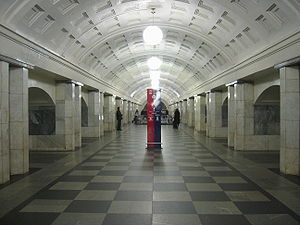- Okhotny Ryad (Moscow Metro)
-
Okhotny Ryad

Moscow Metro station
Station statistics Coordinates 55°45′28″N 37°36′59″E / 55.75778°N 37.61639°E Lines  Sokolnicheskaya Line
Sokolnicheskaya LineConnections Bus: К, 12ц
Trolleybus: 1, 2, 12, 33Structure Pylon triple-vault station Depth 15 metres (49 ft) Levels 1 Platforms 1 Tracks 2 Parking No Bicycle facilities No Baggage check No Other information Opened May 15, 1935 Code 010 Owned by Moskovsky Metropoliten Formerly Okhotnoryadskaya, Imeni Kaganovicha, Prospekt Marksa Traffic Passengers (2002) 35,094,750 Services Preceding station Moscow Metro Following station toward Yugo-ZapadnayaSokolnicheskaya Line Lubyankatoward Ulitsa PodbelskogoTverskayatoward Rechnoy VokzalZamoskvoretskaya Line Transfer at: Teatralnayatoward KrasnogvardeyskayaOkhotny Ryad (Russian: Охотный ряд, Hunting Row) is a station on the Sokolnicheskaya Line of the Moscow Metro. It is located in the centre of Moscow, near the Kremlin.
Okhotny Ryad is located under what was originally the swamplands of the upper Neglinnaya River. Later two ancient churches stood on the site, and their graveyards were excavated during the construction of the station.
The construction of Okhotny Ryad presented a number of engineering challenges. The task of wedging a metro station into the narrow space between two major buildings (Hotel Moskva that is now being re-built, and what is now the State Duma building) at a depth of only 8 metres (26 ft) without damaging their foundations was further complicated by the difficult soil conditions in the area, including numerous underground water channels. The station was built using a so-called "German" method in which the station walls were constructed above ground and then lowered into the construction site. This helped to brace the foundations of the nearby buildings during the subsequent construction of the station vault and pylons.
The station was originally planned to be a bi-vault design similar to many London Underground stations, but Lazar Kaganovich, who was in charge of the Metro project at the time, insisted that the station be changed to a tri-vault design after 20 metres (66 ft) of tunnel had already been bored. A major setback occurred when accumulated rainwater broke through the vault before it had been completely sealed and flooded the station. Though no one was injured in the disaster, construction had to be halted while the damage was repaired.
The station opened as part of the original Metro line on 15 May 1935. The architects, Yuri Revkovskiy, N. Borov, and G. Zamskoi, employed a silvery marble from Italy for the finishing of the pylons, the only documented case where imported material was used in the Metro. The walls are faced with ceramic tile. The finishing of the station, which involved the installation of more than 3,000 square metres (32,000 sq ft) of marble, 20,000 square metres (220,000 sq ft) of plaster, and thousands of square metres of tile as well as lighting and decorations, was completed in just two weeks.
When Teatralnaya station was completed in 1944, it was connected to Okhotny Ryad via new escalators in the centre of the platform. This necessitated the removal of the station's original floor lamps, which were then replaced with spherical ceiling fixtures. A second transfer corridor was opened in 1974 to relieve congestion. In 2004, Okhotny Ryad underwent a major renovation which included replacing the lighting elements inside the spheres and repainting the plaster from light beige to white.
The station has two vestibules, one at either end of the station. The southern one was located in the ground floor of the Hotel Moskva and the northern one, which is shared with Teatralnaya, is built into a building on the northeast corner of Tverskaya and Okhotny Ryad streets. The facade of this building was redesigned by Dmitry Chechulin and originally incorporated sculptures of athletes which were modeled after performers from the Moscow Circus. During the construction of the vestibules the orders of the Moscow's party committee prohibited the obstruction of traffic, so American bridges had to be built over the pits of the future vestibules.
Okhotny Ryad has been renamed more times than any other Metro station. Planned to be called Okhotnoryadskaya, it was opened as Okhotny Ryad instead. The station was renamed Imeni Kaganovicha in honour of Lazar Kaganovich during the brief period between 25 November 1955 and 1957, when its original name was restored. The station's name was changed once more on 30 November 1961, to Prospekt Marksa (the station still contains a mosaic portrait of Karl Marx). Finally, on 5 June 1990, the original name was restored once more.
An average of 42,110 passengers per day enter the station through its vestibules with an additional 241,000 passengers entering via Teatralnaya.
Transfers
Okhotny Ryad is connected to Teatralnaya of the Zamoskvoretskaya Line with subway. Passengers can also transfer to Ploshchad Revolyutsii of the Arbatsko-Pokrovskaya Line through Teatralnaya (Okhotny Ryad and Ploshchad Revolyutsii are not directly connected to each other).
Categories:- Buildings and structures completed in 1935
- Moscow Metro stations
- Railway stations opened in 1935
Wikimedia Foundation. 2010.

